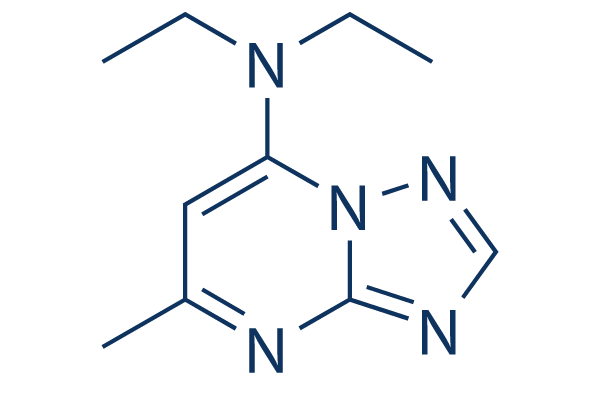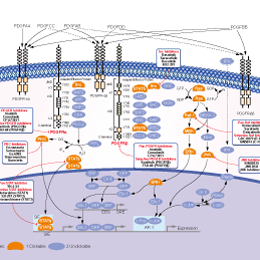
- Bioactive Compounds
- By Signaling Pathways
- PI3K/Akt/mTOR
- Epigenetics
- Methylation
- Immunology & Inflammation
- Protein Tyrosine Kinase
- Angiogenesis
- Apoptosis
- Autophagy
- ER stress & UPR
- JAK/STAT
- MAPK
- Cytoskeletal Signaling
- Cell Cycle
- TGF-beta/Smad
- DNA Damage/DNA Repair
- Compound Libraries
- Popular Compound Libraries
- Customize Library
- Clinical and FDA-approved Related
- Bioactive Compound Libraries
- Inhibitor Related
- Natural Product Related
- Metabolism Related
- Cell Death Related
- By Signaling Pathway
- By Disease
- Anti-infection and Antiviral Related
- Neuronal and Immunology Related
- Fragment and Covalent Related
- FDA-approved Drug Library
- FDA-approved & Passed Phase I Drug Library
- Preclinical/Clinical Compound Library
- Bioactive Compound Library-I
- Bioactive Compound Library-Ⅱ
- Kinase Inhibitor Library
- Express-Pick Library
- Natural Product Library
- Human Endogenous Metabolite Compound Library
- Alkaloid Compound LibraryNew
- Angiogenesis Related compound Library
- Anti-Aging Compound Library
- Anti-alzheimer Disease Compound Library
- Antibiotics compound Library
- Anti-cancer Compound Library
- Anti-cancer Compound Library-Ⅱ
- Anti-cancer Metabolism Compound Library
- Anti-Cardiovascular Disease Compound Library
- Anti-diabetic Compound Library
- Anti-infection Compound Library
- Antioxidant Compound Library
- Anti-parasitic Compound Library
- Antiviral Compound Library
- Apoptosis Compound Library
- Autophagy Compound Library
- Calcium Channel Blocker LibraryNew
- Cambridge Cancer Compound Library
- Carbohydrate Metabolism Compound LibraryNew
- Cell Cycle compound library
- CNS-Penetrant Compound Library
- Covalent Inhibitor Library
- Cytokine Inhibitor LibraryNew
- Cytoskeletal Signaling Pathway Compound Library
- DNA Damage/DNA Repair compound Library
- Drug-like Compound Library
- Endoplasmic Reticulum Stress Compound Library
- Epigenetics Compound Library
- Exosome Secretion Related Compound LibraryNew
- FDA-approved Anticancer Drug LibraryNew
- Ferroptosis Compound Library
- Flavonoid Compound Library
- Fragment Library
- Glutamine Metabolism Compound Library
- Glycolysis Compound Library
- GPCR Compound Library
- Gut Microbial Metabolite Library
- HIF-1 Signaling Pathway Compound Library
- Highly Selective Inhibitor Library
- Histone modification compound library
- HTS Library for Drug Discovery
- Human Hormone Related Compound LibraryNew
- Human Transcription Factor Compound LibraryNew
- Immunology/Inflammation Compound Library
- Inhibitor Library
- Ion Channel Ligand Library
- JAK/STAT compound library
- Lipid Metabolism Compound LibraryNew
- Macrocyclic Compound Library
- MAPK Inhibitor Library
- Medicine Food Homology Compound Library
- Metabolism Compound Library
- Methylation Compound Library
- Mouse Metabolite Compound LibraryNew
- Natural Organic Compound Library
- Neuronal Signaling Compound Library
- NF-κB Signaling Compound Library
- Nucleoside Analogue Library
- Obesity Compound Library
- Oxidative Stress Compound LibraryNew
- Plant Extract Library
- Phenotypic Screening Library
- PI3K/Akt Inhibitor Library
- Protease Inhibitor Library
- Protein-protein Interaction Inhibitor Library
- Pyroptosis Compound Library
- Small Molecule Immuno-Oncology Compound Library
- Mitochondria-Targeted Compound LibraryNew
- Stem Cell Differentiation Compound LibraryNew
- Stem Cell Signaling Compound Library
- Natural Phenol Compound LibraryNew
- Natural Terpenoid Compound LibraryNew
- TGF-beta/Smad compound library
- Traditional Chinese Medicine Library
- Tyrosine Kinase Inhibitor Library
- Ubiquitination Compound Library
-
Cherry Picking
You can personalize your library with chemicals from within Selleck's inventory. Build the right library for your research endeavors by choosing from compounds in all of our available libraries.
Please contact us at info@selleckchem.com to customize your library.
You could select:
- Antibodies
- Bioreagents
- qPCR
- 2x SYBR Green qPCR Master Mix
- 2x SYBR Green qPCR Master Mix(Low ROX)
- 2x SYBR Green qPCR Master Mix(High ROX)
- Protein Assay
- Protein A/G Magnetic Beads for IP
- Anti-Flag magnetic beads
- Anti-Flag Affinity Gel
- Anti-Myc magnetic beads
- Anti-HA magnetic beads
- Poly DYKDDDDK Tag Peptide lyophilized powder
- Protease Inhibitor Cocktail
- Protease Inhibitor Cocktail (EDTA-Free, 100X in DMSO)
- Phosphatase Inhibitor Cocktail (2 Tubes, 100X)
- Cell Biology
- Cell Counting Kit-8 (CCK-8)
- Animal Experiment
- Mouse Direct PCR Kit (For Genotyping)
- New Products
- Contact Us
research use only
Trapidil PDGFR antagonist
Trapidil (Rocornal, Trapymin, Avantrin, Trapymine) is a PDGF antagonist that can inhibit the proliferation of the PDGF-producing glioma cells.

Chemical Structure
Molecular Weight: 205.26
Purity & Quality Control
Batch:
Purity:
99.94%
99.94
Related Products
| Related Targets | PDGFRα PDGFRβ | Click to Expand |
|---|---|---|
| Related Products | Crenolanib CP-673451 Orantinib (SU6668) Tyrphostin AG 1296 PP121 AZD2932 | Click to Expand |
| Related Compound Libraries | Kinase Inhibitor Library Tyrosine Kinase Inhibitor Library PI3K/Akt Inhibitor Library Cell Cycle compound library Angiogenesis Related compound Library | Click to Expand |
Signaling Pathway
Mechanism of Action
| Targets |
|
|---|
In vitro |
||||
| In vitro | Trapidil interrupts the autocrine loop at the PDGF and PDGF-receptor level. This compound has proved to possess a significant antiproliferative activity[1]. The addition of 100 to 400 μg/ml of this chemical significantly reduced cell proliferation induced by different growth factors (FCS, PDGF-BB, bFGF, EGF), the highest inhibitory effect being on PDGF-BB stimulated Mesangial cell(MC) growth. The effect of the drug was dose-dependent and seemingly specific. It is an anti-platelet drug active against various aggregating agents, such as collagen, ADP, arachidonic acid, PAF and calcium ionophore. It exerts its action by blocking the biosynthesis of thromboxane A2 and antagonizing its effect at the receptor level, and by stimulating the synthesis and release of prostacyclin[2]. This agent strongly inhibited osteoclast formation in co-cultures of bone marrow cells and osteoblasts without affecting receptor activator of NF-κB ligand (RANKL) or osteoprotegerin expression in osteoblasts. In addition, it suppressed RANKL-induced osteoclast formation from osteoclast precursors. The compound reduced RANKL-induced expression of nuclear factor of activated T cells, cytoplasmic 1 (NFATc1), a master transcription factor for osteoclastogenesis, without affecting the expression of c-Fos that functions as a key upstream activator of NFATc1 during osteoclastogenesis. It has also been reported to inhibit phosphodiesterase, thromboxane A2, and CD40 signaling and activate protein kinase A[3]. | |||
|---|---|---|---|---|
| Cell Research | Cell lines | Human Mesangial cell lines | ||
| Concentrations | 100 μg/ml | |||
| Incubation Time | 96 h | |||
| Method | Cell viability was determined by Trypan blue dye exclusion test and LDH assay. Supernatants, collected from cells seeded in serum-free medium and exposed to the different mitogens and drugs tested, were centrifuged and LDH concentration determined. Supernatants obtained from sonicated cells were used as a positive control. Furthermore, to definitely exclude a cytotoxic effect of Trapidil on human MC, cells incubated for four days with and without this compound were challenged with fresh medium containing 10% FBS, and cell proliferation evaluated. |
|||
In Vivo |
||
| In vivo | Trapidil is an antiplatelet drug with specific platelet-derived growth factor antagonism and antiproliferative effects in the rat and rabbit models after balloon angioplasty[1]. This compound had a potent inhibitory effect on osteoclast formation and bone resorption induced by interleukin-1 in an animal model. No abnormal symptoms, such as changes in body weight, diarrhea, high fever, and convulsion, were observed after intraperitoneal injections of this chemical[3]. | |
|---|---|---|
| Animal Research | Animal Models | ICR mice |
| Dosages | 5 or 20 mg/kg | |
| Administration | i.p. | |
References |
|
Chemical Information
| Molecular Weight | 205.26 | Formula | C10H15N5 |
| CAS No. | 15421-84-8 | SDF | Download SDF |
| Synonyms | Rocornal, Trapymin, Avantrin, Trapymine | ||
| Smiles | CCN(CC)C1=CC(=NC2=NC=NN12)C | ||
Storage and Stability
| Storage (From the date of receipt) | |||
|
In vitro |
DMSO : 41 mg/mL ( (199.74 mM) Moisture-absorbing DMSO reduces solubility. Please use fresh DMSO.) Water : 41 mg/mL Ethanol : 41 mg/mL |
Molecular Weight Calculator |
|
In vivo Add solvents to the product individually and in order. |
In vivo Formulation Calculator |
|||||
Preparing Stock Solutions
Molarity Calculator
In vivo Formulation Calculator (Clear solution)
Step 1: Enter information below (Recommended: An additional animal making an allowance for loss during the experiment)
mg/kg
g
μL
Step 2: Enter the in vivo formulation (This is only the calculator, not formulation. Please contact us first if there is no in vivo formulation at the solubility Section.)
% DMSO
%
% Tween 80
% ddH2O
%DMSO
%
Calculation results:
Working concentration: mg/ml;
Method for preparing DMSO master liquid: mg drug pre-dissolved in μL DMSO ( Master liquid concentration mg/mL, Please contact us first if the concentration exceeds the DMSO solubility of the batch of drug. )
Method for preparing in vivo formulation: Take μL DMSO master liquid, next addμL PEG300, mix and clarify, next addμL Tween 80, mix and clarify, next add μL ddH2O, mix and clarify.
Method for preparing in vivo formulation: Take μL DMSO master liquid, next add μL Corn oil, mix and clarify.
Note: 1. Please make sure the liquid is clear before adding the next solvent.
2. Be sure to add the solvent(s) in order. You must ensure that the solution obtained, in the previous addition, is a clear solution before proceeding to add the next solvent. Physical methods such
as vortex, ultrasound or hot water bath can be used to aid dissolving.
Tech Support
Answers to questions you may have can be found in the inhibitor handling instructions. Topics include how to prepare stock solutions, how to store inhibitors, and issues that need special attention for cell-based assays and animal experiments.
Tel: +1-832-582-8158 Ext:3
If you have any other enquiries, please leave a message.
* Indicates a Required Field






































